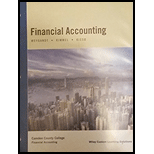
Concept explainers
(a)
Perpetual Inventory System:
Perpetual Inventory System refers to the inventory system that maintains the detailed records of every inventory transactions related to purchases, and sales on a continuous basis. It shows the exact on-hand-inventory at any point of time.
First-in-First-Out:
In First-in-First-Out method, the costs of the initially purchased items are considered as cost of goods sold, for the items which are sold first. The value of the ending inventory consists of the recent purchased items.
Last-in-Last-Out:
In Last-in-First-Out method, the costs of last purchased items are considered as the cost of goods sold, for the items which are sold first. The value of the closing stock consists of the initial purchased items.
Moving -average cost method:
Under moving average cost method, the company calculates a new average cost after every purchase is made. It is determined by dividing the cost of goods available for sale by the units on hand.
To Compute: The cost of ending inventory of L Boards for each cost flow using perpetual inventory system.
(b)
Perpetual Inventory System:
Perpetual Inventory System refers to the inventory system that maintains the detailed records of every inventory transactions related to purchases, and sales on a continuous basis. It shows the exact on-hand-inventory at any point of time.
First-in-First-Out:
In First-in-First-Out method, the costs of the initially purchased items are considered as cost of goods sold, for the items which are sold first. The value of the ending inventory consists of the recent purchased items.
Last-in-Last-Out:
In Last-in-First-Out method, the costs of last purchased items are considered as the cost of goods sold, for the items which are sold first. The value of the closing stock consists of the initial purchased items.
Moving -average cost method:
Under moving average cost method, the company calculates a new average cost after every purchase is made. It is determined by dividing the cost of goods available for sale by the units on hand.
To Compare: The ending inventories between the perpetual inventory system, and the periodic inventory system.
(c)
Perpetual Inventory System:
Perpetual Inventory System refers to the inventory system that maintains the detailed records of every inventory transactions related to purchases, and sales on a continuous basis. It shows the exact on-hand-inventory at any point of time.
First-in-First-Out:
In First-in-First-Out method, the costs of the initially purchased items are considered as cost of goods sold, for the items which are sold first. The value of the ending inventory consists of the recent purchased items.
Last-in-Last-Out:
In Last-in-First-Out method, the costs of last purchased items are considered as the cost of goods sold, for the items which are sold first. The value of the closing stock consists of the initial purchased items.
Moving -average cost method:
Under moving average cost method, the company calculates a new average cost after every purchase is made. It is determined by dividing the cost of goods available for sale by the units on hand.
To Identify: The inventory cost flow method which gives the same ending inventory, and which gives different ending inventory values under periodic, and perpetual inventory system.
Trending nowThis is a popular solution!

Chapter 6 Solutions
FINANCIAL ACCOUNTING W/WILEY+ >IP<
- Which accounting principle states that expenses should be recorded in the period in which they are incurred? a) Matching principleb) Consistency principlec) Revenue recognition principled) Conservatism principlearrow_forwardHarriet Corporation manufactures kitchen appliances. During the month with highest production, 5,200 mixers were manufactured at a total cost of $78,000. In the month of lowest production, the company made 2,800 mixers at a cost of $51,000. Using the high-low method of cost estimation, total fixed costs arearrow_forwardDo fast answer general accounting questionarrow_forward
- Which of the following is not a type of financial statement?A. Income StatementB. Balance SheetC. Trial BalanceD. Statement of Cash Flowsarrow_forwardPlease help me solve this financial accounting problem with the correct financial process.arrow_forwardDon't use ai given answer accountingarrow_forward

 AccountingAccountingISBN:9781337272094Author:WARREN, Carl S., Reeve, James M., Duchac, Jonathan E.Publisher:Cengage Learning,
AccountingAccountingISBN:9781337272094Author:WARREN, Carl S., Reeve, James M., Duchac, Jonathan E.Publisher:Cengage Learning, Accounting Information SystemsAccountingISBN:9781337619202Author:Hall, James A.Publisher:Cengage Learning,
Accounting Information SystemsAccountingISBN:9781337619202Author:Hall, James A.Publisher:Cengage Learning, Horngren's Cost Accounting: A Managerial Emphasis...AccountingISBN:9780134475585Author:Srikant M. Datar, Madhav V. RajanPublisher:PEARSON
Horngren's Cost Accounting: A Managerial Emphasis...AccountingISBN:9780134475585Author:Srikant M. Datar, Madhav V. RajanPublisher:PEARSON Intermediate AccountingAccountingISBN:9781259722660Author:J. David Spiceland, Mark W. Nelson, Wayne M ThomasPublisher:McGraw-Hill Education
Intermediate AccountingAccountingISBN:9781259722660Author:J. David Spiceland, Mark W. Nelson, Wayne M ThomasPublisher:McGraw-Hill Education Financial and Managerial AccountingAccountingISBN:9781259726705Author:John J Wild, Ken W. Shaw, Barbara Chiappetta Fundamental Accounting PrinciplesPublisher:McGraw-Hill Education
Financial and Managerial AccountingAccountingISBN:9781259726705Author:John J Wild, Ken W. Shaw, Barbara Chiappetta Fundamental Accounting PrinciplesPublisher:McGraw-Hill Education





